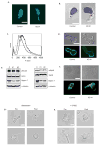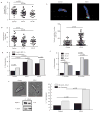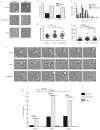Amoeboid T lymphocytes require the septin cytoskeleton for cortical integrity and persistent motility
- PMID: 19043408
- PMCID: PMC3777658
- DOI: 10.1038/ncb1808
Amoeboid T lymphocytes require the septin cytoskeleton for cortical integrity and persistent motility
Abstract
The systems that refine actomyosin forces during motility remain poorly understood. Septins assemble on the T-cell cortex and are enriched at the mid-zone in filaments. Septin knockdown causes membrane blebbing, excess leading-edge protrusions and lengthening of the trailing-edge uropod. The associated loss of rigidity permits motility, but cells become uncoordinated and poorly persistent. This also relieves a previously unrecognized restriction to migration through small pores. Pharmacologically rigidifying cells counteracts this effect, and relieving cytoskeletal rigidity synergizes with septin depletion. These data suggest that septins tune actomyosin forces during motility and probably regulate lymphocyte trafficking in confined tissues.
Figures






Comment in
-
Undressing a cellular corset: septins exposed.Nat Cell Biol. 2009 Jan;11(1):9-10. doi: 10.1038/ncb0109-9. Nat Cell Biol. 2009. PMID: 19122592 No abstract available.
References
-
- Snapper SB, et al. WASP deficiency leads to global defects of directed leukocyte migration in vitro and in vivo. J Leukoc Biol. 2005;77:993–8. - PubMed
-
- Snapper SB, et al. N-WASP deficiency reveals distinct pathways for cell surface projections and microbial actin-based motility. Nat Cell Biol. 2001;3:897–904. - PubMed
-
- Jacobelli J, Chmura SA, Buxton DB, Davis MM, Krummel MF. A Single Class II Myosin Modulates T cell Motility and Stopping But Not Synapse Assembly. Nature Immunology. 2004;5:531–538. - PubMed
Publication types
MeSH terms
Substances
Grants and funding
LinkOut - more resources
Full Text Sources
Other Literature Sources
Molecular Biology Databases
Research Materials

